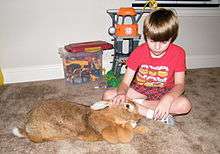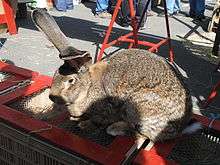Flemish Giant rabbit
The Flemish Giant rabbit is a very large breed of domestic rabbit (O. cuniculus domesticus), and is normally considered to be the largest breed of the species. Flemish giants are a utility breed, and are most commonly bred for fur and meat. The breed is also known for its docile nature and patience in being handled, resulting in the animals commonly being kept as pets.
History
The Flemish Giant originated in Flanders. It was bred as early as the 16th century near the city of Ghent, Belgium. It is believed to have descended from a number of meat and fur breeds, possibly including the Steenkonijn (Stone Rabbit—referring to the old Belgian weight size of one stone or about 3.76 kg (8 lb 5 oz)) and the European "Patagonian" breed (now extinct).[1] This "Patagonian" rabbit, a large breed that was once bred in Belgium and France, was not the same as the Patagonian rabbit of Argentina (Sylvilagus brasiliensis), a wild species of a different genus weighing less than two pounds[2] (about 1 kg), nor the Patagonian mara (Dolichotis patagonum), sometimes called the Patagonian hare, a species in the cavy family of rodents that cannot interbreed with rabbits.[3] Thomas Coatoam, in his Origins of the Flemish Giants, tells us, "The earliest authentic record of the Flemish Giant Rabbit occurred about the year 1860."[4]

The first standards for the breed were written in 1893. The Flemish Giant is an ancestor of many rabbit breeds all over the world, one of which is the Belgian Hare,[1] imported into England in the mid 19th century. The Flemish Giant was exported from England and Belgium to America in the early 1890s to help improve the size of meat rabbits during the great "rabbit boom".[5]
It received little attention until about 1910 where it started appearing at small livestock shows throughout the country. Today, it is one of the more popular breeds at rabbit shows because of its unusually large size and its varying colors. It is promoted by the National Federation of Flemish Giant Rabbit Breeders, which was formed in 1915. The Flemish Giant has many nicknames, first and foremost the "Gentle Giant" for its uniquely docile personality and also the "universal rabbit" for its varied purposes as pet, show, breeding, meat and fur animal.[6]
Appearance

As one of the largest breeds of domestic rabbit, the Flemish Giant is a semi-arch type rabbit with its back arch starting behind the shoulders and carrying through to the base of the tail giving a "mandolin" shape. The body of a Flemish Giant Rabbit is long and powerful, with relatively broad hindquarters. The fur of the Flemish Giant is known to be glossy and dense. When stroked from the hindquarters to the head, the fur will roll back to its original position.
Bucks have a broad, massive head in comparison to does, and can take 1.5 years to reach full maturity. Does may have a large, full, evenly carried dewlap (the fold of skin under their chins), and can take 1 year to reach their full maturity.
Flemish Giant Rabbits weigh 15 pounds on average, though the biggest ones can weigh up to 22 lb, and the longest one on record (in fact, holding the record for the longest rabbit in the world of any kind), measured about 4 feet 3 inches long.[7]
The American Rabbit Breed Association (ARBA) standard recognized seven different colors for this breed: black, blue, fawn, sandy, light gray, steel gray, and white.[8] The show standard minimum weight for a senior doe is 14 lb (about 6.4 kg), and the show standard minimum weight of a Senior buck is 13 lb (about 5.9 kg).
Behavior and lifestyle

Flemish Giants can be docile and tolerant of handling; frequent interaction with humans is a requirement for this to occur. Flemish Giants, like all rabbits, can become fearful, and sometimes aggressive, if handled incorrectly or irresponsibly. Their larger frame requires special attention paid to the spine alignment when handling a Flemish Giant, or any rabbit for that matter. Consequently, potential owners should consider these factors in addition to their size, level of food consumption, and substantial waste production before buying.
Due to its large size, the Flemish Giant needs substantial living quarters that provide ample opportunity for physical movement. The House Rabbit Society recommends keeping rabbits inside the home in a very large pen or room(s) in the home. Larger dog crates are often more appropriate than traditional rabbit and small-pet cages, which tend to be smaller and shorter. In the United States Department of Agriculture's standards for animal housing, rabbits over 12 pounds must have at least five square feet of floor space.[9] The size of appropriate living quarters increases with size of the rabbit.
Cages with incorrectly sized wire gauge bottoms (as opposed to small gauge wire or solid bottoms) can harm the feet of a Flemish Giant more so than smaller house rabbits due to their increased weight. A resting board may be required to prevent sore hocks for a larger breed rabbit.[6] The Flemish Giant will require larger quantities of food compared to smaller breeds of domestic rabbits. Like some other short hair breeds of rabbits, the Flemish Giant will usually require mild attention to grooming due to its shorter hair. Shedding during the spring and fall transition periods tend to be the most dramatic, with smaller sheds often occurring in between.
Diet
Flemish Giants can be fed like other rabbits, with the amount of food increased to match their larger size.[10] ARBA recommendations include hay and occasional treats.
A high protein diet of 16% or more is needed for them to gain bone mass while growing and later when muscle mass develops. Apples, cabbage or broccoli in small amounts can be given as treats and slowly increased. A quarter apple per rabbit every other day for 3 weeks can be increased to a half apple after that. Do not feed the core or seeds to the rabbit. Since Flemish Giants do not reach full size until they are 1.5 years old, they need to be fed a lot until then. When females have babies and during winter, they need to be fed as much as they can eat, and given plenty of water.
In supplementing a commercial diet, care must be taken to avoid excess protein, calories, and minerals such as salt and calcium, which in excess can cause kidney stones. Overfeeding leading to obesity is a major health concern for both commercial and pet rabbits.[11]
The House Rabbit Society recommends 2 cups of chopped leafy vegetables per 6 pounds (3 kg) of body weight and no more than 2 tablespoons of fruit or carrots per 6 pounds of body weight daily.[12]
Breeding

The American Rabbit Breeders' Association (ARBA) recommends delaying breeding of female rabbits until they reach the senior weight range. For Flemish Giants, this is 14 pounds, and a typical rabbit will reach this weight when they are about 9 months to one year.[11] A Flemish Giant can take up to 1.5 years to reach their maximum weight and a breeder should wait until the rabbit is slightly over a year old before breeding. Females and males can become sexually mature at 4 months and 8 days. Once the rabbits are 3 months old they should be kept in separate cages or put females with females and males with males. If fighting occurs then they must be separated. The breeding lifespan of a rabbit is variable. Some breeders prefer not to have any more litters after the age of three years [13] while others continue to produce quality litters for five to eight years. The gestation period is between 28–31 days. On average they give birth at 30–32 days. The Flemish Giant rabbit can produce large litters, usually between 5 and 12 in a litter.
A nesting box filled with hay is given to the female as she prepares for birth. After birth, clean out the hay, replace with some new hay, and check to see if babies are all alive. Check box every day in case babies die and take them out.
Uses
Apart from being kept as a pet, the Flemish Giant is used for meat, fur, show, pet assisted therapy and education.
4-H and show
Flemish Giants, due to their uncomplicated grooming requirements and docile personalities, are used by 4-H programs throughout the United States as a starter rabbit for teaching children responsibility and care of farm animals and pets.[14] Another very popular youth program outside of 4-H that promotes responsible show breeding is the National Federation of Flemish Giant Breeders Youth Program.[15] Flemish Giants are the second oldest domesticated rabbit breed in the United States, following behind the now rare Belgian Hare.
Raising for pets and profit
Flemish Giants make excellent pets as they are calm, but too heavy for most children to handle. They require a lot of space. Outdoor cages should be 5 feet by 3 feet (1.5 meters by 1 meter). Cages must be in the shade so the rabbits do not overheat. Cages should be protected from wind using painter drop cloth. Cages should have solid roofs to protect rabbits from rain and snow. They eat 0.5 kg or more food a day of dried rabbit pellets. They expel a lot of waste. Flemish Giants are not typically regarded as "meat" rabbits because much of the commercial rabbit market focuses on young rabbits, usually around 70 days of age. At this time, Flemish Giants are developing bone mass rather than muscle. However, when raised to roasting (under 6 months) and stewing (over 6 months) age, the size of the Flemish makes them desirable. They are also often bred with other meat rabbit breeds, such as the New Zealand, to increase both meat-to-bone ratio and litter size.
Due to the large amount of high protein food they consume and the cost of this food, the selling of the Flemish Giants for meat is not profitable, as buyers want to only pay little amount of money per rabbit.
See also
References
- 1 2
- ↑ Buresh, J. 2004. "Sylvilagus brasiliensis" (On-line), Animal Diversity Web. Accessed June 30, 2012
- ↑ http://animaldiversity.ummz.umich.edu/site/accounts/information/Dolichotis_patagonum.html
- ↑ http://www.nffgrb.net/Articles/Origins.htm
- ↑ https://archive.org/details/lairdleesstandar00hall
- 1 2 http://www.nffgrb.net
- ↑ "Longest Rabbit". Guinness World Records. Retrieved April 26, 2017.
- ↑ "ARBA Official Breed ID Guide" (PDF). American Rabbit Breeder Association. Retrieved May 12, 2015.
- ↑ https://web.archive.org/web/20090322014922/http://www.aphis.usda.gov/animal_welfare/downloads/awr/awr.pdf
- ↑ Bass, Gary, 'Feed', Raising Better Rabbits & Cavys, American Rabbit Breeder's Association, 2000
- 1 2 Bennet, Bob, Storey's Guide to Raising Rabbits, Storey Books, North Adams Massachusetts, 2001
- ↑ http://www.rabbit.org/faq/sections/treat.html
- ↑ Rabbit - Flemish Giant
- ↑ http://4h.uwex.edu/onlinpro/rabbits.cfm
- ↑ http://www.nffgrb.net/Youth.htm
External links
| Wikimedia Commons has media related to Flemish Giant. |